4 Common Missteps to Avoid After a Car Accident
Getting into a car accident can be a traumatic and confusing experience. In the midst of the chaos, it’s easy to make mistakes that could affect your recovery and any potential legal claims. Knowing what to avoid can help you navigate this stressful time more smoothly. In this blog, we will discuss common missteps you should steer clear of after a car accident. Our goal is to provide you with valuable tips to protect your rights and help you get back on track.
1. Not Seeking Immediate Medical Attention
One of the biggest mistakes people make after a car accident is not seeking immediate medical attention. Even if you feel fine, some injuries might not present symptoms right away. A medical professional can properly assess your condition, and having these records can be crucial if you decide to pursue a legal claim.
Your health is the most important aspect to consider following an accident. Internal injuries, such as concussions or internal bleeding, may not show immediate symptoms but can be life-threatening if left untreated. By going to a doctor right after the accident, you ensure that any hidden injuries are detected and treated promptly. Additionally, documentation from healthcare providers serves as compelling evidence of injuries when dealing with insurance claims or legal matters.
Emergency responders at the accident scene might perform a preliminary check, but that’s not enough. You need a thorough examination in a medical facility. According to the Car Accident Lawyer in Thousand Oaks, immediate medical attention is not just for your health, but also to avoid any ambiguity in court. Delaying medical treatment can complicate your claims, with insurers arguing that your injuries are not as severe or even unrelated to the accident.
2. Failing to Document the Scene
Failing to document the scene can severely impact your ability to claim damages later. Take photos of the cars involved, the surrounding area, and any visible injuries. Gather contact information from witnesses and jot down your own account of what happened as soon as possible.
When documenting the scene, think of yourself as an investigator. Capture images from multiple angles showing vehicle damage, license plates, street signs, and traffic signals. Your goal is to recreate the entire scene visually. These photos serve as concrete proof when negotiating with insurance companies or presenting in court. The lack of such documentation can make it harder to prove fault or the extent of damages.
In addition to photos, collect all possible contact information from witnesses. Eyewitness accounts can be very persuasive when recounting the events of the accident. Don’t hesitate to ask for their names, phone numbers, and email addresses. If they are willing, record short statements on your phone. This can make a significant difference if disputes arise about what happened. According to Abkarian & Associates, making these efforts can thwart future challenges from insurance companies trying to undermine your claims.
3. Admitting Fault at the Scene
It’s natural to feel overwhelmed after an accident, but admitting fault at the scene can have legal repercussions. Even saying something as simple as ‘I’m sorry’ can be interpreted as an admission of guilt. It’s best to keep your words to a minimum and let the insurance companies and attorneys handle liability determinations.
In the heat of the moment, emotions run high and you may feel inclined to apologize, but it’s crucial to resist this urge. Any statements you make can be recorded and used by insurance adjusters to minimize your claim. Instead, exchange necessary information with the other party and provide a factual, straightforward account of the incident to the responding officers without speculating on fault. This is also the perfect moment to document the scene as previously advised.
Remember, determining fault is a complex process that involves an assessment of traffic laws, witness statements, and accident reconstruction. By admitting fault prematurely, you may inadvertently shoulder the financial burden of repair costs, medical expenses, and higher insurance premiums. For a more detailed breakdown on why you should avoid admitting fault, visit our comprehensive guide on personal accident.
4. Delaying Contact with an Attorney
Many people underestimate the importance of contacting an attorney soon after an accident. A car accident attorney in Thousand Oaks can provide valuable guidance and help you navigate the legal complexities. The sooner you get professional advice, the better your chances of a favorable outcome.
Time is of the essence when dealing with car accidents. Evidence can deteriorate, memories can fade, and the legal deadlines for filing claims can expire. Reaching out to an attorney right away ensures that your case is managed from the start. They can advise you on gathering evidence, documenting your injuries, and communicating with insurance adjusters to prevent any early mistakes that might weaken your claim.
An attorney also serves as your advocate, handling all communications with insurance companies and ensuring that your interests are protected. They can help calculate the full extent of your damages, including medical costs, lost wages, and emotional distress, crafting a comprehensive claim that reflects the true impact of the accident. For a deeper understanding of why timely legal intervention is critical, our article on timing matters when contacting a car accident lawyer will offer valuable insights.

